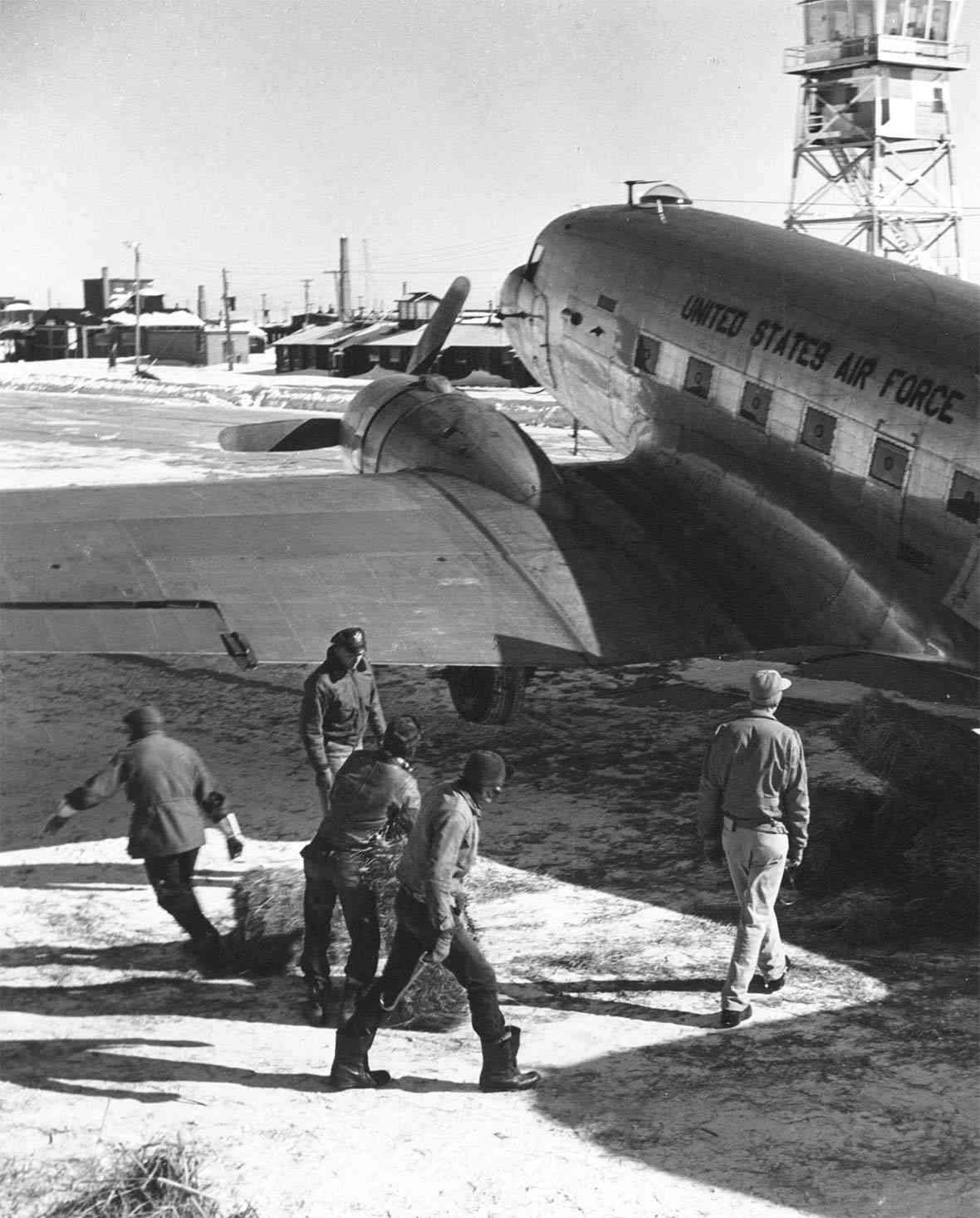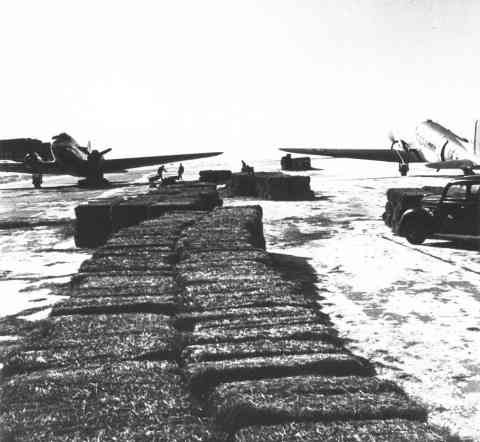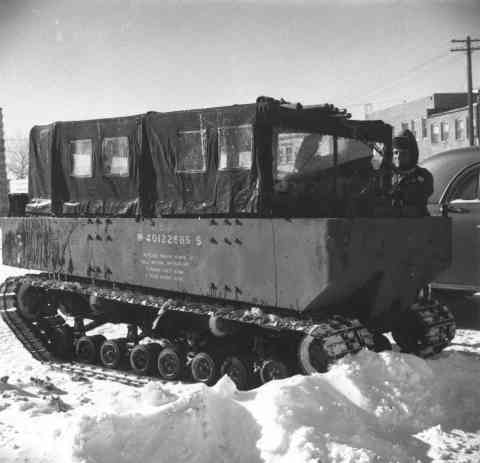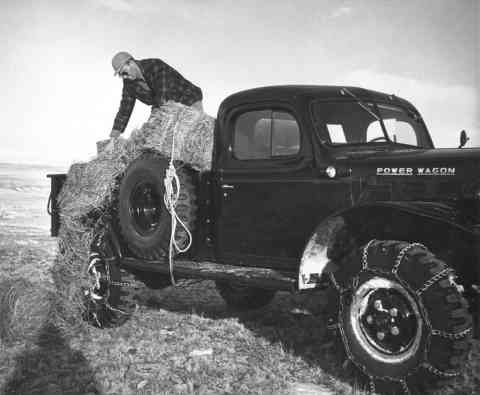- Home
- Encyclopedia
- The Notorious Blizzard of 1949
The Notorious Blizzard of 1949
A cold, raging wind drove snow so hard that it scoured the eyes and nostrils like sand. Twenty-one year old Merle Hahn and his father were struggling to drive their cattle into their barn, but ice had frozen over the animals' eyes, blinding them. Handling their cattle in whiteout conditions near their ranch house in northern Goshen County, Wyo. had proven so difficult that Hahn's father decided to leave them where they'd clustered by the south end of the barn. There was no entrance on that side for the herd, so the two men cut a hole. Then, after all that effort, the cattle refused to go in.
Meanwhile, in Pine Bluffs, Wyo., at least two trains were stuck. Their passengers and crews flooded the small town, straining hotels, cafes and private homes to bursting. All across southeast Wyoming, northern Colorado, western South Dakota and western Nebraska, hundreds of people risked their lives in the storm to search for stranded motorists, missing neighbors or family members.
The blizzard started on Sunday Jan. 2, 1949 and proved the worst of the century. The first storm would be followed by two more months of snow and bitter cold. The National Weather Service eventually reported 12 people dead in Wyoming after the first storm. Twenty-eight more died in western South Dakota, Colorado and Nebraska. On March 1, after the federal government had completed rescue operations, the official death toll for the whole region was 76. Unofficial estimates are somewhat higher.

The blizzard
That first Sunday, a dark gray cloud advancing from the northwest “was like hitting a wall,” Bill Miskimins recalled later. He first ran into the storm a few miles from his family's ranch 14 miles northwest of LaGrange, Wyo. Temperatures dropped from the mid-30s in the forenoon to 10 below zero or colder by evening. Winds gusted to 66 miles per hour, and snow blew everywhere.


Within hours, roads were impassable. Cars stuck in ditches or were buried under 10-foot drifts. People began to worry about loved ones traveling home after the holidays, while many ranchers were setting out on the usually routine but suddenly dangerous trek to feed and water their cattle and sheep, sometimes pastured miles away. Given that some people got lost in the storm just trying to get from their house to a nearby corral or barn, these longer journeys could turn deadly.
Many travelers struggled from their disabled cars to the nearest ranch house—something they would be strongly advised against doing now. At the houses they were taken in along with other strangers. Some private dwellings were so crowded that there wasn't enough room for all to sleep at once. Some stood while others rested, taking turns.
By Wednesday afternoon, January 5, the sky was clear and sunny but hardships continued because the wind did not let up. More storms piled on more and more snow through the middle of February. Snowplows would clear the road or railroad tracks but overnight the wind again packed snow into just-cleared spaces. Drifts, some as high as 20 feet, were packed so hard that crews used dynamite to break them up.
The toll in human and animal suffering was immense. People whose limbs froze were lucky if they lost only a few fingers or toes. During the first blizzard, a man left his wife and baby in their car to search for help. He died after falling off a snowdrift just three-quarters of a mile from the Fred E. Warren ranch house in southeast Wyoming.
Cattle and sheep suffocated when they were buried in drifts or when their nostrils filled with the dense, grainy snow. Many that survived the initial onslaught later had to be put down because their feet and legs had frozen. In some cases, milk cows’ teats and bulls’ testicles froze off.
“We lost our whole herd,” recalled Alice Kimball, who was 21 at the time and ranched with her husband near Deer Creek eight miles south of Glenrock, Wyo. “I think they died of pneumonia.”
Government help
State and federal agencies launched various relief efforts, ultimately referred to as Operation Snowbound. On the first day of the storm, the Wyoming National Guard's 187th Fighter Squadron began ground operations including, by Tuesday January 4, when the storm was still raging, a team of men, probably on snowshoes, who hand-pulled a toboggan load of food to a family north of Cheyenne.
The Civil Air Patrol, National Guard and many small private planes were soon flying, delivering food and medicine. On January 5, A.G. Crane, acting governor since Lester Hunt had been elected to the U.S. Senate the previous November, declared a state of emergency and appointed the Laramie County chapter of the American Red Cross as coordinator for the agencies involved in rescue and relief. A later proclamation by Crane supported the Legislature's creation of the Wyoming Emergency Relief Board on Jan. 19, 1949. Lawmakers appropriated $200,000 and later added another $500,000.
By January 26, due to continued storms and high winds, the arduous work of clearing roads, airlifting supplies, rescuing stranded travelers and carrying doctors to sick or frozen people—or transporting patients to hospitals—had overburdened state agencies, county relief boards and local volunteers. So state officials asked the federal government for help. President Truman declared the snowbound western states disaster areas, with the worst sectors of Nebraska, South Dakota and Wyoming designated as special “distress areas.” Truman authorized a total of $700,000, of which Wyoming received $125,000.
At the peak of Wyoming operations, about 600 pieces of snow-moving equipment were on the roads. The total rescue effort involved countless volunteers and local agencies plus at least 10 major state and federal agencies from the U.S. Army to the National Park Service. Private businesses, including railroad and oil companies, also lent manpower and heavy equipment to the work. Radio stations in Cheyenne, Rawlins, Sheridan and Casper, with special permission from the Federal Communications Commission, broadcast individual pleas for help. So many people called the highway department to ask if their loved ones had been found that officials installed a separate line with an unpublished number, just so they could communicate with their staff and carry on their work.
Operation Haylift
Operation Haylift began on January 28, when the U.S. Air Force flew a total of about 550 tons of hay from Marshall Field, Kan., and La Junta, Colo., to Casper. Feed was also delivered to other parts of Wyoming, with bales sometimes dropped on the range near stranded cattle and sometimes delivered to towns for convoy to isolated ranches.

The Wyoming Game and Fish Department began emergency feeding of deer, elk and antelope in early January and continued through the first part of March. About 21,000 animals were given hay, cottonseed cake and alfalfa pellets. Sometimes hay bales were delivered on a toboggan that men pulled by hand because roads were impassable for vehicles. Game birds were also fed corn and small grain.
A survey of approximately 1,000 farmers and ranchers, completed in early June 1949, reported livestock losses for the hardest hit counties: Fremont, Sweetwater, Carbon, Natrona, Johnson, Campbell, Crook, Weston, Converse, Goshen, Albany, Laramie, Niobrara and Platte. Of this 14-county population of 686,000 cattle, 20,000 were estimated dead; and out of 1.5 million sheep, 100,000 dead. Spring breeding also suffered because many bulls were sterile and in general, livestock was left weak and depleted.
Fortunately, gradual spring thaws prevented major floods and furnished abundant water for irrigation. And, despite the high mortality rate in livestock, not all animals buried in drifts died. Bill Fraser, a Pine Bluffs resident at the time, reported that “[T]hree months after the storm a farm[er] near Albin dug a pig out of a snow bank still alive.”
The Hahn cattle never did go into the south end of the barn. Sixty-one years later, Merle Hahn speculated that the cattle were smart enough to know that there was not supposed to be a south entrance; Hahn and his father ended up driving the herd around to the east side where, luckily, no drift blocked the doorway there.
Resources
Primary Sources
- “Emergency Relief Board of County Organized Tuesday; Aim is to Aid All Stockmen; Feed is Not Included.” Lusk Free Lance, Jan. 27, 1949. In Snow Flurries to the Blizzard of '49 as Told by Those Who Saw, Endured, and Survived What is Described as the Worst Blizzard in History. Lusk, Wyo.: 2012, 40.
- Fraser, Bill. Personal story via email to Jimmy and Carmen Shane. In Snow Flurries to the Blizzard of '49 as Told by Those Who Saw, Endured, and Survived What is Described as the Worst Blizzard in History. Lusk, Wyo.: 2012, 152.
- Jewell, Loretta, ed. The Blizzard in Black and White, Winter 1948-49: A Scrapbook Album of Photographs and Stories as Told by the Survivors. Vol. 1 and Vol. 2. Carpenter, Wyo.: Our Family Circle Press, 2002.
- Kimball, Alice. Telephone interview with the author. Feb. 10, 2015.
- Leichliter, Vern. “Body of Storm Victim Found.” The Wyoming Eagle, Jan. 12, 1949. In The Blizzard in Black and White, Winter 1948-49: A Scrapbook Album of Photographs and Stories as Told by the Survivors. Carpenter, Wyo.: Our Family Circle Press, 2002, Vol. 1, 49.
- Miskimins, Bill. “White Death―The '49 Blizzard.” In Snow Flurries to the Blizzard of '49 as Told by Those Who Saw, Endured, and Survived What Is Described as the Worst Blizzard in History. Lusk, Wyo.: 2012, 94.
- “Second Storm Closes Roads and Hampers Livestock Rescue Work.” Lusk Herald, Jan. 20, 1949. In Snow Flurries to the Blizzard of '49 as Told by Those Who Saw, Endured, and Survived What is Described as the Worst Blizzard in History. Lusk, Wyo.: 2012, 17.
- Shane, Jimmy, and Carmen Shane and Friends. Snow Flurries to the Blizzard of '49 as Told by Those Who Saw, Endured, and Survived What is Described as the Worst Blizzard in History. Lusk, Wyo.: 2012.
- Sparling, Helen. “42 Marooned in 4-Room Ranch House Had Little to Eat: Slept in Relays.” Wyoming State Tribune, Jan. 6, 1949. In The Blizzard in Black and White, Winter 1948-49: A Scrapbook Album of Photographs and Stories as Told by the Survivors. Carpenter, Wyo.: Our Family Circle Press, 2002, Vol. 2, 97.
- “Ten Streamliner Cars Derailed by Bulldozer Here.” Pine Bluffs Post, Jan. 13, 1949. In The Blizzard in Black and White, Winter 1948-49: A Scrapbook Album of Photographs and Stories as Told by the Survivors. Carpenter, Wyo.: Our Family Circle Press, 2002. Vol. 1, 64.
- “Three-Day Blizzard Strikes This Area. 425 Stranded Here Until Thurs., When First Highways Opened.” Lusk Herald, Jan. 6, 1949. In Snow Flurries to the Blizzard of '49 as Told by Those Who Saw, Endured, and Survived What is Described as the Worst Blizzard in History. Lusk, Wyo.: 2012, 9.
Secondary Sources
- Alleman, Roy V. Blizzard 1949. St. Louis, Mo.: Patrice Press, 1991, 76-81, 147-150, 156, 176-177.
- Beebe, Ruth. Reminiscing Along the Sweetwater. Boulder, Colo.: Johnson Publishing Co., 1973, 159-162.
- Dumbrill, Lucille and Earl Christensen. “The Blizzard of 1949 in Weston County.” Annals of Wyoming, 68: 1, Winter 1996, 2-3. Accessed Feb. 3, 2015, at https://archive.org/stream/annalsofwyom68141996wyom#page/n1/mode/2up.
- Hahn, Merle. “The Blizzard of 1949.” Good Old Days, March/April 2010, 42-43. In Snow Flurries to the Blizzard of '49 as Told by Those Who Saw, Endured, and Survived What is Described as the Worst Blizzard in History. Lusk, Wyo.: 2012, 125-126.
- Larson, T. A. History of Wyoming, 2d. ed., rev. Lincoln, Neb.: University of Nebraska Press, 1978, 546.
- Lawrence, Amy, James L. Ehernberger and Lucille Dumbrill. “Wyoming Memories: Blizzard of 1949.” Annals of Wyoming, 76: 1, Winter 2004, 31-37. Accessed Feb. 3, 2015, at https://archive.org/stream/annalsofwyom76142004wyom#page/n1/mode/2up.
- Love, Louise, ed. Report of Wyoming's “Operation Snowbound.” Cheyenne, Wyo.: 1949, 13, 15-19, 22, 47, 58, 72-76, 82, 94, 152.
- Rogstad, Jodi. “Remembering a Monster.” Wyoming Tribune-Eagle, Dec. 28, 2008. WyomingNews.com. Accessed Feb. 3, 2015, at http://www.wyomingnews.com/articles/2008/12/28/featured_story/01top_12-28-08.txt#.VMKgVCj7sRY.
- United States Department of Commerce, National Oceanic and Atmospheric Administration, Rapid City, S. Dak. “The Blizzard of January 1949.” Accessed March 9, 2015, at http://www.crh.noaa.gov/unr/?n=01-02-49-blizzard.
- United States Department of Commerce, Weather Bureau. Climatological Data: Wyoming, January 1949. LVIII: 1. Washington, D.C.: 1949. Accessed Feb. 15, 2015, at http://www.ncdc.noaa.gov/IPS/cd/cd.html.
- Wyoming Legislature. Session Laws of the State of Wyoming Passed by the Thirtieth State Legislature. Sheridan, Wyo.: Mills Company, Printers, Binders, Stationers, 4-6.
For further reading and research
- To view "Storm of the Century: the Blizzard of '49," a one-hour documentary produced by Wyoming PBS, together with transcripts of the full, uncut interviews of Wyoming residents who witnessed the event, visit http://wyomingpbs.org/blizzard49.php.
Illustrations
- All the photos are from the Morrison Collection at the Casper College Western History Center. Used with permission and thanks.
